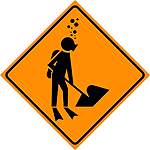|
| |

|
This page under construction.
Here are some of the topics that will be covered in this chapter. More text and images will eventually be added to this section. Thank you for your patience.
|
- Surf grass beds are at their most lush in late fall, when the plant must grow rapidly so it isn't buried under sand returning toward shore. Surf grass blooms in fall and then produces clusters of small, hard seeds. These seeds will ripen just in time to be disbursed by the first winter storms.
- Some annual intertidal red algae begin to rot and die back, before being "pruned" or torn out by winter storms.
- The blades of some annual brown algae, such as Laminaria, begin to release spores, and in the process, become tattered and torn. The spores will be dispersed by winter storm waves, with a few surviving in tiny cracks and crevices.
- Young black abalone settle into tide pools after drifting around for about three months. The young abalone settle under rocks and eat bacterial films. During winter, they will switch to eating diatom films and coralline red algae (both common during the winter months)
- Owl limpets, one of the largest limpets on the Central Coast, begin to spawn in September or October and will continue throughout the winter.
- Although they are common throughout summer and fall, two of the most common tidepool animals, hermit crabs and black turban snails, reach maximum abundance in the tide pools in October. Many will perish during winter storms.
- Cabezon, a large, predatory fish, migrates into intertidal areas in October to spawn. Males build nests, then try to entice females to lay their eggs (which are poisonous to many animals). The males then guard these nests until they hatch.
|
